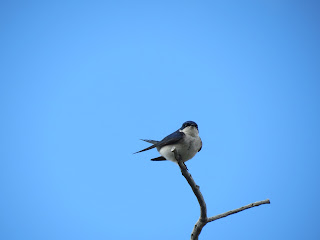It was entertaining to watch these flying steamer-ducks diving from the restaurant
The white-crested elaenia is one of the easiest members of its genus to identify
We started out heading towards the ranch. We stopped at a waterfall (Salto Chica) to check for torrent ducks, but none were seen. We then stopped at a small lagoon where white-tufted grebes, upland geese, flying steamer-ducks and spectacled ducks were all present, but nothing new. Another nearby lagoon provided similar birds, but a flock of 7 silvery grebes was new.
The silvery grebe is one of only three grebes that inhabit Torres Del Paine
Our next stop was at a much larger lagoon, where there was an enormous flock of Chilean flamingos very close to the shore. We walked up to them, then walked around the lagoon to see two southern wigeons, several crested ducks, three red-gartered coots and a pair of Austral negritos on the ground.
This Chilean flamingo was very accommodating and allowed lots of photos
Southern wigeons really put their Eurasian cousins to shame
In contrast, these crested ducks are much drabber, but also less widespread
As we were leaving the flamingo lagoon we also saw another Patagonian fox.
In the right light, the legs of the Patagonian fox appear a beautiful reddish-orange
Our next stop was the Aonikenk walk. The walk extends towards cave paintings, but we were only exploring the start of it: an area with many lagoons. The lagoons were filled with birds, including our first yellow-billed pintails, red shovelers and lake ducks. A cinerous harrier was also flying overhead. On the way back there were several guanacos close to the trail.
The lake duck is actually related to Australia's blue-billed duck
Yellow-billed pintails are common through much of South America
This cinerous harrier stayed around long enough for me to get this photo
Spot the bird edition 2: red shoveler
These guanacos didn't seem bothered by humans at all
We continued forward. From that point guanacos were fairly common. A few lesser rheas were also present, but too far away to photograph. We stopped at another waterfall, Cascada Paine, to look for torrent ducks, but again they weren't there. We stopped again to watch a flock of 6 Andean condors flying around, most likely they had scented some corpse for them to feed on. Two chimango caracaras were also in the area. Soon we arrived at the ranch.
The rapids near Cascada Paine are apparently good for torrent ducks, though we didn't see any
The ranch itself wasn't too birdy, apart from many Chilean swallows that were flying around and a few house wrens in the trees.
Both Chilean swallows (like this one) and blue-and-white swallows inhabit Patagonia
After that we walked to a nearby wetland. On the shores of the wetland were nesting red-gartered coots and silvery grebes, as well as a few Magellanic oystercatchers. In the water was a small flock of southern wigeons, a few crested ducks and 3 yellow-billed pintails. Trees near the wetland held nothing but a single Austral thrush. We stopped during our walk to see some upland goose eggs that had been abandoned.
This crested duck was near the trail and allowed some good photos
A Magellanic oystercatcher next to the nest of a red-gartered coot
You can just make out the silvery grebe sitting on its nest
These Upland goose eggs were on a beach next to the trail
This southern lapwing attempted to lure us away from its nest by pretending its wing was broken
Again, the drive back was fairly uneventful.



















No comments:
Post a Comment